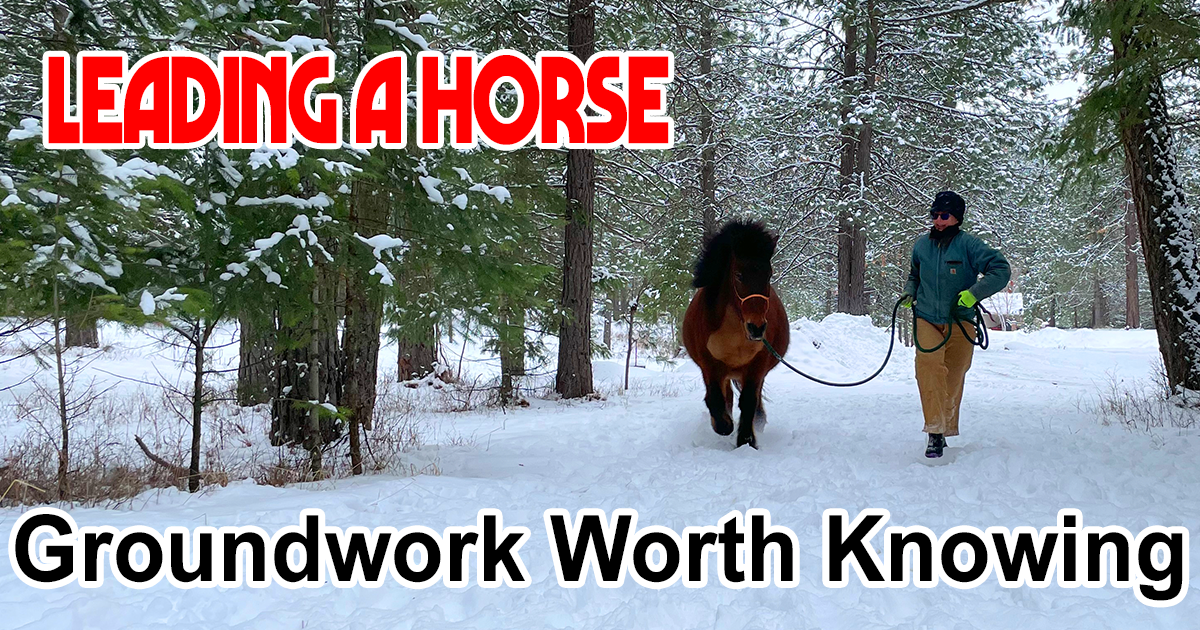Leading for Leadership
Leading a horse and doing groundwork is not busywork for groundwork’s sake; it is about finding and correcting minor issues before they have a chance to become major problems. Fixing these minor snags sets you up for success in the saddle and on the trail.
All groundwork, and indeed all horsemanship, is about having our horse focus on us and not the myriad of distractions surrounding us. A horse who won’t lead well tends to be less accommodating when ridden. Skills that are rough on the ground don’t get better when you’re in the saddle. Having your horse lead easily beside you rather than lagging or racing ahead sets both you and the horse up for success in all your endeavors.
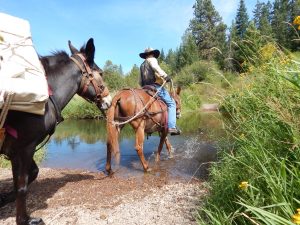
The results of effective leading training go far beyond groundwork.
What I look for when leading is a horse that walks willingly alongside me, whether I’m walking, jogging, or running with no tension on the lead rope. I want the horse to keep pace with me without pulling the lead.
Achieving this requires that we focus on our timing and consistency. We need to release pressure immediately when the horse responds to our cues. Consistency in our cues and expectations is also critical. Even if you don’t mind when your horse creeps forward or occasionally gets too far behind, once the horse learns that you will give an inch, and when it matters, he may take a mile. I used to think that it was OK for my horse to have lousy ground manners because he was fine when under saddle. I was wrong. He wasn’t fine, and I didn’t know better.
Here’s how I work on leading skills with my animals:
The Preparatory Command
Early in my Marine Corps career, I learned the value of close-order drills, i.e., marching. In the military, one purpose of teaching parade deck skills is instilling discipline by creating habits of precision and automatic response to orders. Although it takes time to get to the point where units move as a fully coordinated element, the results were astounding when we were proficient. The key is practicing and training regularly so that the commands become second nature.
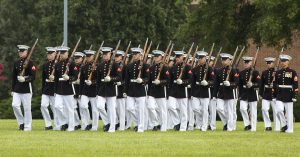
Marines of the U.S. Marine Corps Silent Drill Platoon. (Official U.S. Marine Corps photo by Cpl. Robert Knapp/Released)
In the military, orders are typically given in two parts: the preparatory command, which gains your attention and readies you for action, and the command of execution which tells you when to act. An example is when a drill instructor wants a group of recruits to move from one place to another: “Forward, march!” In this case, forward is the preparatory command, and march is the command of execution. When these words are spoken, or perhaps yelled, the Marines know what they are supposed to do and when they are supposed to do it. What works with Marines also works with horses.
Leading the Horse
To begin leading, I stand at the pony’s shoulder. The preparatory command is “walk,” and the execution command is “on.” Initially, the horse won’t know what you’re asking with the cue and will simply stand there. That’s OK at the beginning. When the horse doesn’t move, I’ll tell him to move by applying pressure on the lead rope. As soon as the horse moves, release the tension. If you’re consistent with releasing pressure, your horse will quickly learn that “walk-on” means moving with you without stress. If you’re inconsistent with the release, you’ll teach him to rely on pressure to move, which means you’ll constantly be pulling, which is no fun for anyone.
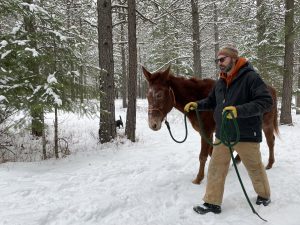
The finished product is us moving together with an utterly slack rope. There should be no pressure on the lead as we’re both moving alongside each other.
I use the “Ask then Tell” method with my animals. If the ask doesn’t work, I tell them what will happen. Another way to describe this is CPR – cue, pressure, and response. The cue is the ask, pressure is the tell, and the response is what we want our horse to do. Our goal is to remove the tell, or pressure, as quickly as possible to have only the cue and the response.
If the horse moves past your shoulder, the first thought may be to pull back on the lead, and I try not to at first. In the beginning, it’s normal for the critter to move ahead; after all, that’s what you’ve just asked it to do. The horse is just trying too hard, which is much better than not trying at all. As we progress together, we’ll both find the happy medium where we’re both moving at the same rate, side by side.
The finished product is us moving together with an utterly slack rope. There should be no pressure on the lead as we’re both moving alongside each other. We’ll get to that goal much quicker if we take the time to get the first steps right.
Go for more
Once you’re moving forward nicely, it’s time to up the ante and focus on refinement. When leading a horse, I want my animals to stay even with their neck at my shoulder. Once we begin packing, we’ll move that spot behind me.
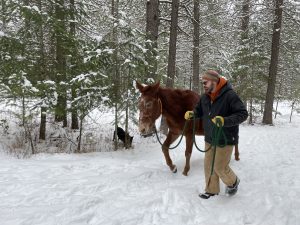
Focus on refinement.
If the horse should go past my shoulder, I can ask him to get back with a verbal “back .”If that doesn’t work, I can give the lead a bump to slow him up just a touch.
Every horse is an individual and has a different threshold for the amount of “Tell” they respond best to. I find the personality differences between my girls fascinating. Ellie is quite reactive and guarded, while Cocoa is much more laid back about life in general. I can push Cocoa a bit, whereas we’ll suffer for my eagerness if I ask too much of Ellie. Horse and mules are not one size fits all creatures. Each is a beautiful individual that brings a unique set of traits to the party. It’s my job to use the appropriate training style to help them realize their potential.
Don’t hold them back
A tendency that I had when I started my equine affair was to pull back on the lead to keep my horse in check and beside me. That taught him to rely on that pressure and eventually gave me a sore arm. The horse should be responsible for staying in the proper position.
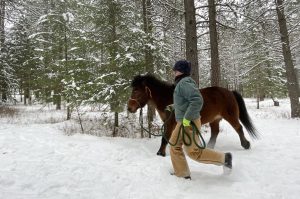
horse will cue into your body signals as you move from one gait to another.
After walking has progressed and is going well, it’s now time to incorporate transitions into the mix. Shift from a walk to a jog to a run and back down again. I use verbal cues such as “trot” just before shifting speed to give the critter a heads up that something is about to change. Soon your horse will be cueing into your body signals as you move from one gait to another.
The Turn
Eventually, you’ll make a change in direction while leading. There are several ways of doing this; I prefer to have my horse move away from me and push him into the turn. This makes him think about my personal space, which is important for our continued education. If you pull your horse into you while turning, he doesn’t have a choice but to enter your space, and I don’t want that to become a habit.
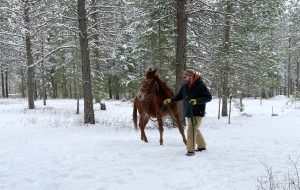
I prefer to have my horse move away from me and push him into the turn. This makes him think about my personal space, which is important for our continued education.
For me, these many words on the simple act of leading a horse are the foundation of everything that he and I will do together. Whether we’re on a backcountry pack trip or closer to home, these basic exercises carry over into every part of our lives together. The better our horses become at “follow the leader” on the ground, the better our relationships will be on the trail.
For more of my thoughts on trail riding and camping with horses, as well as the world’s most comprehensive guide to horse trails and camps, please give us a visit at www.TrailMeister.com. You can also find more information in the best-selling book “The ABCs of Trail Riding and Horse Camping – Essential Knowledge for Trail and Camp.” You can find more info on the book here: https://amzn.to/3CuErid


